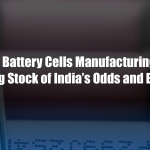IS THE GIGA DEMAND FOR BATTERY CELLS THE NEXT BIG OPPORTUNITY IN INDIA ?
“Necessity is the mother of Invention” is a well-known proverb.
As EVs take centre stage in India, the spotlight is squarely on addressing the battery cell, its costliest component. After all, the motive is to be Clean, Green and Affordable for faster adoption of new age electric mobility.
Li-on technology for battery cell is still the most viable solution as it also finds wide applications in electronic gadgets, tele-communication and industrial applications as well as in aerospace.
World’s lithium-ion manufacturing market is currently dominated by China with a 77% share as of 2020 and is likely to continue to do so till Europe catches up to 25% capacities by the year 2025. To reduce dependence on imports, especially from China, the Indian Government is pushing heavily for self-reliance in Li-on battery manufacturing as well as backing research and development efforts for alternative energy solutions. Lithium is tipped to replace crude oil as the most important commodity for economic growth in the coming decade. Equally ambitious are India’s plans for Grid Storage.
Giga Opportunity
The demand for EVs is set to rise exponentially in India and if things pan out as planned by the Govt., there will be 20 million EVs produced annually by the year 2026.
“India has great scope for the production of electric-vehicle batteries locally because it has access to the raw materials, a $20 billion manufacturing incentive plan, a proposed battery materials policy and improving prospects for demand” says Vikram Handa of Epsilon Advanced Materials Pvt. Ltd., India’s first manufacturer of lithium-ion battery parts.
The Government’s PLI scheme outlay for Advanced Chemistry Cells (ACC) is $2.5 billion.
As per International Energy Agency’s (IEA), India Energy Outlook 2021 projections, India could have 140-200GW of battery storage capacity by the year 2040, potentially a third of total battery storage capacity in the world by then.
It is evident that global cell manufacturers as well as Tier 1 and 2 suppliers have a huge opportunity to explore possibilities of JVs and technology transfer agreements. The field has been cleared by government agencies. From research to innovation and from technology transfers to setting up giga factories, the avenues of entry are here more than ever before.
Miles to go & players right now
India’s space agency, ISRO’s Vikram Sarabhai Space Research Centre (VSSC) has successfully developed and qualified lithium-ion cells of capacities ranging from 1.5 Ah to 100 Ah for use in satellites and launch vehicles. To enable the Zero Emission Policy of India and accelerate development of indigenous electric vehicle industry, ISRO has selected 10 companies for transfer of its lithium-ion technology. Amara Raja Batteries Ltd. is the first company to set up a development hub towards utilising ISRO’s technology transfer.
However, the gap in fulfilling the demand for domestically manufactured battery cells is growing at a rapid pace.
India’s first lithium-ion battery manufacturing plant, TDSG, is being set up in the state of Gujarat through a JV between Toshiba, Denso and Suzuki. The companies have signed an MOU with the Gujarat State Govt.
As elucidated in our previous article here, a number of top Indian companies have already geared up to establish gigawatt factories.
Major Indian companies venturing into battery cell manufacturing include:
1.Reliance Industries
2.Adani Group
both these leading corporate giants of India want to create giga scale factories to enable advanced energy generation, storage and grid connectivity.
3.Tata Chemicals plans to invest ₹40 billion INR towards setting up a 10 GW plant in Gujarat.
Some foreign entrants include New York’s C4V that plans a manufacturing base and EV makers Triton EV and Tesla dabbling in it as well.
It is worth noting that Indian cell manufacturing is still in its nascent stage and there are a number of challenges to overcome as well as opportunities to explore.

Manufacturing by setting up a factory and availing the benefits of the PLI scheme. The competitive bidding scheme under the scheme for ACC requires minimum criteria to qualify. No specific technology is mandated so, to qualify, there is room for any new generation technologies that can store electric energy either as electrochemical or as chemical energy and convert it back to electric energy. The subsidy will be a function of achieved capacity, value addition, actual production and the discounting factor proposed in the scheme. In a nutshell, it is a well -constructed scheme with the intent of incentivizing localization of the supply chain in the advanced chemistry cell manufacturing in India.
Partnerships with Indian cell manufacturers that require
1. advanced technology solutions – for battery cell components
2. cell design technology solutions
3. direct supply of battery cell components i.e. the cathode, anode, electrolyte, etc.
4. R&D technical tie-ups to find solutions for India market
5. Innovations and R&D efforts like barley husk ash-based silicon anodes and Univ. of Warwick’s, WMG’s technology of accurate temperature monitoring to enable charging current lithium batteries 5 times faster than current recommended limits.
If R&D efforts and technology solutions are adapted to the Indian climate and customer context, such partnerships and tech transfer agreements can forge a completely new path for battery solutions in India as well as in other countries around the globe.
Raw Materials for cell manufacturing
India has few exploitable options to produce lithium and the discovery of 1600kgs of lithium in Mandla district of Karnataka is the latest addition. India lacks raw lithium, cobalt, and nickel reserves, but has significant reserves of steel, aluminium, copper, graphite, and manganese. Latin America and other nations around the world have far larger reserves of lithium. India has a lot of catching up to do with respect to research and study of potential deposits of lithium. Until then, the government is in the process of establishing free trade agreements with nations in South America, Congo and South Africa to access lithium reserves and form mutually beneficial partnerships.
Urban mining
As the demand, regulations and subsidies for EVs rise, India’s lithium cell imports are likely to be above 10GWh by year 2025. This translates to a need of recycling capacity in excess of 60,000 tonnes – mining rare metals out of waste piles aka Urban Mining. Companies like Tata Chemicals, Lohum and Gravita India are amongst the early birds either ready or getting there to set up plants. However, the untapped potential remains huge.
Conclusion
A conservative estimate forecasts the size of Indian battery market demand to be $48 billion USD between years 2020-2030 thus leveraging the PLI Scheme outlay by 20 times.

India is now the preferred destination and home to R&D and Design centres for automobile manufacturers from around the world. Adding Cell Technology and its Manufacturing dynamics to this mix is going to be a game changer.
To know more about opportunities in the Indian Battery Cell market contact me at sudhir.nerurkar@quanzen.in




